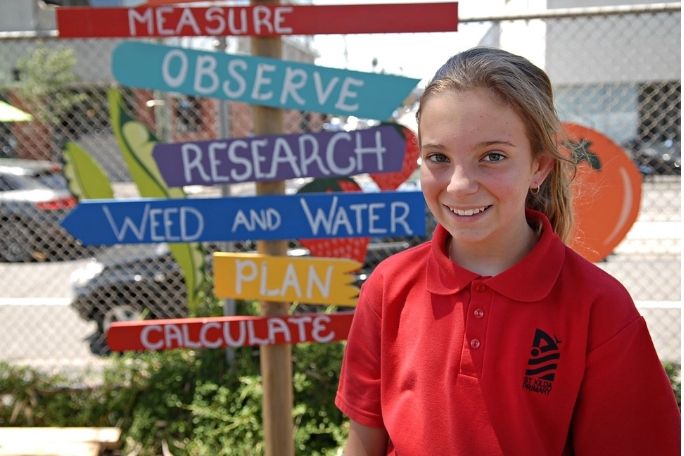Lesson summary
Students participate in a mapping exercise, working as a class to create a map of the human-made, animal and environmental features of their school. Students begin by clarifying their understanding of key terms relating to this lesson and then work as a class to walk around the school identifying and recording key human-made, animal and environmental features. Back in the classroom students work together to create a map of their school that incorporates the features they identified, with younger students adding photos and annotations to their map and older students creating and incorporating symbols to portray these features on their map. Finally, students reflect on how some of the features of their school could be improved.
Learning intentions:
Students will...
- understand the differences between human-made, animal and environmental features
- understand how a map can be used to portray a range of information
Success criteria:
Students can...
- collect data about their school
- identify and locate features on a map
- write labels for a map
- work collaboratively
- create symbols (Year 2)
Lesson guides and printables
Lesson details
Curriculum mapping
Australian curriculum content descriptions:
Foundation HASS:
- Pose questions about past and present objects, people, places and events (ACHASSI001)
- Collect data and information from observations and identify information and data from sources provided (ACHASSI002)
- Sort and record information and data, including location, in tables and on plans and labelled maps (ACHASSI003)
- Reflect on learning to propose how to care for places and sites that are important or significant (ACHASSI009)
- Present narratives, information and findings in oral, graphic and written forms using simple terms to denote the passing of time and to describe direction and location (ACHASSI010)
Year 1 HASS:
- Pose questions about past and present objects, people, places and events (ACHASSI018)
- Collect data and information from observations and identify information and data from sources provided (ACHASSI019)
- Sort and record information and data, including location, in tables and on plans and labelled maps (ACHASSI020)
- Interpret data and information displayed in pictures and texts and on maps (ACHASSI024)
- Draw simple conclusions based on discussions, observations and information displayed in pictures and texts and on maps (ACHASSI025)
- Reflect on learning to propose how to care for places and sites that are important or significant (ACHASSI026)
- Present narratives, information and findings in oral, graphic and written forms using simple terms to denote the passing of time and to describe direction and location (ACHASSI027)
Year 2 HASS:
- Pose questions about past and present objects, people, places and events (ACHASSI034)
- Collect data and information from observations and identify information and data from sources provided (ACHASSI035)
- Sort and record information and data, including location, in tables and on plans and labelled maps (ACHASSI036)
- Interpret data and information displayed in pictures and texts and on maps (ACHASSI040)
- Draw simple conclusions based on discussions, observations and information displayed in pictures and texts and on maps (ACHASSI041)
- Reflect on learning to propose how to care for places and sites that are important or significant (ACHASSI042)
NESA and VCAA: Click here for NESA and VCAA curriculum links for this lesson
General capabilities: Critical and Creative Thinking
Cross-curriculum priority: Sustainability OI.5
Relevant parts of Foundation HASS achievement standards: Students observe the familiar features of places and represent these features and their location on pictorial maps. They reflect on their learning to suggest ways they can care for a familiar place. Students compare observations about familiar places.
Relevant parts of Year 1 HASS achievement standards: Students respond to questions about familiar places by collecting and interpreting information and data from observations. They represent the location of different places and their features on labelled maps. They reflect on their learning to suggest ways they can care for places.
Relevant parts of Year 2 HASS achievement standards: Students pose questions about familiar places. They locate information from observations and interpret information and data to draw simple conclusions. They record data in tables, plans and on labelled maps. They reflect on their learning to suggest ways to care for places. Students communicate findings in a range of texts using language to describe location
Unit of work: Roots & Shoots – Lower Primary.
Time required: 100+ mins
Level of teacher scaffolding: High – lead students in observing school yard and creating map
Resources required
- Device capable of presenting a website to the class
- Device capable of taking photos, such as a tablet or camera
- Simple map of the school that can be annotated (A2 sized or larger)
- Drawing materials
- Google Maps
Skills
- Collaboration
- Communication
- Creativity
- Critical thinking
Additional info
This lesson has been developed in partnership with Jane Goodall’s Roots & Shoots program. Roots & Shoots is a global youth-led program of young people taking action to improve our world. By participating in this lesson, you and your students will be joining thousands of young people and teachers working to make positive change in our world.


Welcome back!
Don't have an account yet?
Log in with:
By signing up to Cool.org you consent and agree to Cool's privacy policy to
store, manage and process your personal information. To read more, please see
our privacy policy here(Opens in new tab).
Create your free Cool.org account.
Many of our resources are free, with an option to upgrade to Cool+ for premium content.
Already have an account?
Sign up with:
By signing up to Cool.org you consent and agree to Cool's privacy policy to
store, manage and process your personal information. To read more, please see
our privacy policy here(Opens in new tab).